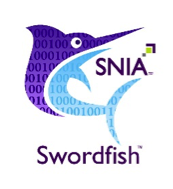 By George Ericson, Distinguished Engineer, Dell EMC; Member, SNIA Scalable Storage Management Technical Working Group, @GEricson
By George Ericson, Distinguished Engineer, Dell EMC; Member, SNIA Scalable Storage Management Technical Working Group, @GEricson
Introduction
This blog is part one of a three-part series recently published on “The Data Cortex”, which represents the thoughts and opinions from members of the CTO Team of Dell EMC’s Data Protection Division. The author, George Ericson, has been actively participating on the SNIA Scalable Storage Management Technical Working Group which has been developing the SNIA Swordfish storage management specification.
storage management specification.
SNIA Swordfish is an extension to the Distributed Management Task Force’s (DMTF’s) open industry Redfish® standard, and the combination offers a unified approach to managing storage
and servers in environments like hyperscale and cloud infrastructures. This makes having a single portal convenient for obtaining feedback on either specification. SNIA’s Storage Management Initiative (SMI) has set up swordfishforum.com as an easy link that goes to the Redfish Forum site. Please visit often and share your thoughts.
Overview
There is a very real opportunity to take a giant step towards universal and interoperable management interfaces that are defined in terms of what your clients want to achieve. In the process, the industry can evolve away from the current complex, proprietary and product specific interfaces.
You’ve heard this promise before, but it’s never come to pass. What’s different this time? Major players are converging storage and servers. Functionality is commoditizing. Customers are demanding it more than ever.
Three industry-led open standards efforts have come together to collectively provide an easy to use and comprehensive API for managing all of the elements in your computing ecosystem, ranging from simple laptops to geographically distributed data centers.
This API is specified by:
- the Open Data Protocol (OData) from Oasis
- the Redfish Scalable Platforms Management API from the DMTF
- the Swordfish Scalable Storage Management API from the SNIA
One can build a management service that is conformant to the Redfish or Swordfish specifications that provides a comprehensive interface for the discovery of the managed physical infrastructure, as well as for the provisioning, monitoring, and management of the environmental, compute, networking, and storage resources provided by that infrastructure. That management service is an OData conformant data service.
These specifications are evolving and certainly are not complete in all aspects. Nevertheless, they are already sufficient to provide comprehensive management of most features of products in the computing ecosystem.
This post and the following two will provide a short overview of each.
This post and the following two will provide a short overview of each.
OData
The first effort is the definition of the Open Data Protocol (OData). OData v4 specifications are OASIS standards that have also begun the international standardization process with ISO.
Simply asserting that a data service has a Restful API does nothing to assure that it is interoperable with any other data service. More importantly, Rest by itself makes no guarantees that a client of one Restful data service will be able to discover or know how to even navigate around the Restful API presented by some other data service.
OData enables interoperable utilization of Restful data services. Such services allow resources, identified using Uniform Resource Locators (URLs) and defined in an Entity Data Model (EDM), to be published and edited by Web clients using simple HTTP messages. In addition to Redfish and Swordfish described below, a growing number of applications support OData data services, e.g. Microsoft Azure, SAP NetWeaver, IBM WebSphere, and Salesforce.
The OData Common Schema Definition Language (CSDL) specifies a standard metamodel used to define an Entity Data Model over which an OData service acts. The metamodel defined by CSDL is consistent with common elements of the UML v2.5 metamodel. This fact enables reliable translation to your programming language of your choice.
OData standardizes the construction of Restful APIs. OData provides standards for navigation between resources, for request and response payloads and for operation syntax. It specifies the discovery of the entity data model for the accessed data service. It also specifies how resources defined by the entity data model can be discovered. While it does not standardize the APIs themselves, OData does standardize how payloads are constructed and a set of query options and many other items that are often different across the many current Restful data services. OData specifications utilize standard HTTP, AtomPub, and JSON. Also, standard URIs are used to address and access resources.
The use of the OData protocol enables a client to access information from a variety of sources including relational databases, servers, storage systems, file systems, content management systems, traditional Web sites, and more.
Ubiquitous use will break down information silos and will enable interoperability between producers and consumers. This will significantly increase the ability to provide new and richer functionality on top of the OData services.
The OData specifications define:
Conclusion:
While Rest is a useful architectural style, it is not a “standard” and the variances in Restful APIs to express similar functions means that there is no standard way to interact with different systems. OData is laying the groundwork for interoperable management by standardizing the construction of Restful APIs. Next up – Redfish.
 By George Ericson, Distinguished Engineer, Dell EMC; Member, SNIA Scalable Storage Management Technical Working Group, @GEricson
By George Ericson, Distinguished Engineer, Dell EMC; Member, SNIA Scalable Storage Management Technical Working Group, @GEricson Read More
Read More By George Ericson, Distinguished Engineer, Dell EMC; Member, SNIA Scalable Storage Management Technical Working Group, @GEricson
By George Ericson, Distinguished Engineer, Dell EMC; Member, SNIA Scalable Storage Management Technical Working Group, @GEricson storage management specification.
storage management specification. 
 By George Ericson, Distinguished Engineer, Dell EMC; Member, SNIA Scalable Storage Management Technical Working Group, @GEricson
By George Ericson, Distinguished Engineer, Dell EMC; Member, SNIA Scalable Storage Management Technical Working Group, @GEricson storage management specification.
storage management specification.
 If you haven’t caught the updates on SNIA SwordfishTM lately, please read on because it’s swimming fast! The new SNIA specification offers a unified approach to managing storage and servers in environments like hyperscale and cloud infrastructures. SNIA’s Scalable Storage Management Technical Work Group (SSM TWG) just announced completion of
If you haven’t caught the updates on SNIA SwordfishTM lately, please read on because it’s swimming fast! The new SNIA specification offers a unified approach to managing storage and servers in environments like hyperscale and cloud infrastructures. SNIA’s Scalable Storage Management Technical Work Group (SSM TWG) just announced completion of  A new SNIA specification offers a unified approach to managing storage and servers in environments like hyperscale and cloud infrastructures. SNIA on Storage recently sat down with SNIA member volunteers from the Scalable Storage Management Technical Work Group (SSM TWG), who just announced the completion of Version 1.0 of the SNIA SwordfishTM storage management specification, to learn more.
A new SNIA specification offers a unified approach to managing storage and servers in environments like hyperscale and cloud infrastructures. SNIA on Storage recently sat down with SNIA member volunteers from the Scalable Storage Management Technical Work Group (SSM TWG), who just announced the completion of Version 1.0 of the SNIA SwordfishTM storage management specification, to learn more.